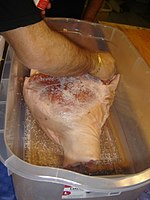
Photo from wikipedia
Seafood is essential to a healthy and varied diet due to its highly nutritious characteristics. However, seafood products are highly perishable, which results in financial losses and quality concerns for… Click to show full abstract
Seafood is essential to a healthy and varied diet due to its highly nutritious characteristics. However, seafood products are highly perishable, which results in financial losses and quality concerns for consumers and the industry. Due to changes in consumer concerns, demand for healthy products has increased. New trends focusing on reducing synthetic preservatives require innovation and the application of additional or alternative strategies to extend the shelf life of this type of product. Currently, refrigeration and freezing storage are the most common methods for fish preservation. However, refrigeration alone cannot provide long shelf-life periods for fish, and freezing worsens sensorial characteristics and consumer interest. Therefore, the need to preserve seafood for long periods without exposing it to freezing temperatures exists. This review focuses on the application of other approaches to seafood products, such as biodegradable films and coating technology; superchilling; irradiation; high-pressure processing; hyperbaric storage; and biopreservation with lactic acid bacteria, bacteriocins, or bacteriophages. The efficiency of these techniques is discussed based on their impact on microbiological quality, sensorial degradation, and overall preservation of the product’s nutritional properties. Although these techniques are already known, their use in the industrial processing of seafood is not widespread. Thus, the novelty of this review is the aggregation of recent studies on shelf life extension approaches, which provide useful information for the selection of the most appropriate technology and procedures and industrial innovation. Despite the fact that all techniques inhibit or delay bacterial proliferation and product decay, an undesirable sensory impact may occur depending on the treatment conditions. Although no technique appears to replace refrigeration, the implementation of additional treatments in the seafood processing operation could reduce the need for freezing, extending the shelf life of fresh unfrozen products.
Journal Title: Foods
Year Published: 2022
Link to full text (if available)
Share on Social Media: Sign Up to like & get
recommendations!